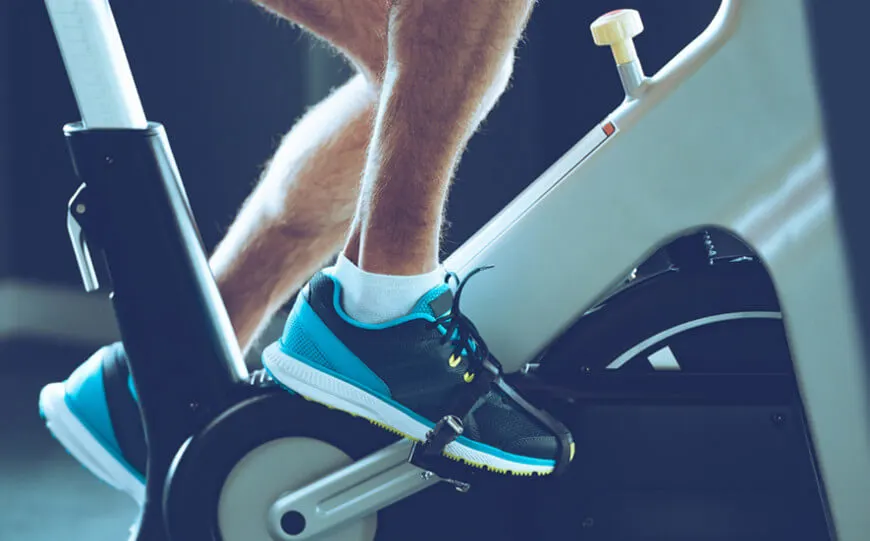Does Stationary Bike for Knee Rehab after torn ligaments help?

A fall while skiing, a football tackle, the knee tilts in and the foot goes outwards, it is the sprain of the knee or what we also call a twisted knee. Pain, inflammation... the cruciate ligaments of the knee have relaxed or torn and it will be necessary, whether or not there is operation, to immobilize the knee and then undergo rehabilitation! Rehab is a key step in the healing process for restoring proper knee coordination and strengthening the muscles that assist and protect the ligaments. What do you need to know about rehabilitation or self-rehabilitation? What should you do, what should you avoid? Is the exercise bike advised? Our answers below!
1. What is exactly a knee sprain?
A knee sprain is a damage of the ligaments in the knee joint. Most sprains occur as a result of twisting the knee and injure the cruciate ligaments (anterior and posterior).
The ligaments are very strong and elastic fibrous tissues which connect the bones to each other in the joint and ensure their stability. They allow the bones to move while fixing limits thanks to their elasticity (and thus avoid the dislocations, that happen when a joint is dislocated). A sprain occurs when the ligaments are too stretched: It is in this case a benign sprain. A severe sprain occurs when a ligament breaks.
Both types of knee sprain:
• A benign sprain is a tear of part of the ligaments
• A severe sprain corresponds to a total rupture of the ligaments
2. Causes and risk factors for knee sprain
The knee is the most exposed joint during the practice of sports such as skiing, football, rugby, tennis or fighting sports. It is no coincidence that 75 to 90% of the cruciate ligament ruptures occur during the practice of a sport.
3. What are the symptoms?
A knee sprain causes severe pain in the knee at the time of the trauma or the accident, cracking or tearing, and a feeling of knee instability. The knee is then swollen, red and taut (usually with the appearance of edema).
After a knee sprain injury, you have difficulty in walking and feel pain as soon as you try to move or bend your knee.
BEWARE. It is absolutely necessary to immediately consult a doctor in case of sprain!
4. Rehab for sprained and twisted knee injuries
The treatment after a knee injury mainly depends on the severity of the injury and therefore the type of sprain. In the case of a benign sprain (partial tear of the ligament), a non-operative treatment is generally prescribed. The first step is to put the knee joint to rest, accompanied by anti-inflammatory and compresses of ice on the knee, then rehab sessions and exercices.
In the case of a rupture of the ligaments (severe sprain), a knee surgery can be considered and the ligament replaced by a tendon graft.
Whatever the type of sprain, there will always be a knee immobilization phase by splint that can last 3 to 4 weeks (or even 6 weeks for a ligament rupture) followed by a rehabilitation phase. The immobilization allows the healing of the wound while stabilizing the joint: its precise duration will be determined by the specialist doctor. The rehabilitation phase will be followed by a physiotherapist.
5. Self-rehabilitation at home with an exercise bike
The aim of rehabilitation is to work on knee mobilization, muscle strengthening and neuro-muscular reprogramming in order to recover the joint amplitude.
The knee joint is supported by the quadriceps, the muscle at the front of the thigh, and the hamstrings at the back of the thigh. It is this muscular system which assists the articulation of the knee and which is the object of a muscular reinforcement via physiotherapy.
It is possible to perform some exercises at home to accompany rehabilitation, this is called self-rehabilitation. Self-rehabilitation can speed recovery and allow you to heal faster! You must in any case talk to your physiotherapist about when you can start it and what you can do.
As soon as you feel confident (you must at least be able to walk properly without crutches) and your physiotherapist allows you, you will be able to do some exercises on your exercise bike at home (if you don't have a stationary bike, the DKN AM-3i is very well adapted to rehab). Physical therapists usually recommend the practice of the exercise bike since it is a gentle, smooth, safe and practical sport to do at home.
WHAT YOU SHOULD KNOW. The exercise bike is also recommended after an ankle sprain because the ankle hardly moves when pedaling (always make sure not to have the leg too tense while pedaling) and does not have to bear the weight of the body.
Make sure to lower the saddle slightly to prevent your leg from tensing too much when pedaling. Start with training sessions of 5 to 10 minutes and increase them gradually. Pedal slowly at the start with a low or average resistance that you can gradually increase over time.
Increase the duration of your training sessions, your speed of pedaling and the level of resistance of your stationary bike according to your feeling and of course the opinion of your physiotherapist. Once you feel confident, you can vary your workouts a little bit by performing accelerations for example or by increasing the resistance of the bike for a few seconds (which is good for improving the strength of the muscles in your legs and thighs) and repeating these exercises several times.
If you feel that the exercise is too demanding, rest for a day before resuming your exercises. The key to success is to be constant and to persevere. Do not stop after the second session!
BEWARE. Do not resume sport too soon because too fast a recovery may lead to chronic instability of the knee.
Our advice for self-rehabilitation after a knee sprain:
1. As soon as you can walk again and your physiotherapist allows you, you can practice self-rehab at home.
2. Start slowly with light exercises on your exercise bike with low resistance for 5 to 10 minutes per day.
3. Slowly and gradually increase the duration of your workouts as well as the pedaling resistance of your stationary bike.
4. Never force! If you feel that you have done too much, take one or two days off before resuming your rehabilitation exercises or your training.
5. Stop immediately in case of pain!
6. It's only by strengthening your muscles that you can relieve your knee joint durably and prevent relapses. You must be constant in your efforts and persevere!

David Anderson
Fitness Writer
David Anderson is a professional coach with 15 years of experience in the sports and fitness industry. He has been writing about fitness and giving workout tips and advice since 2016.
